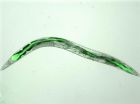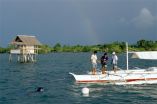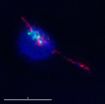(Press-News.org) An ocean's oxygen levels may play a role in the impact of marine predators on bodies when they are immersed in the sea, according to Simon Fraser University researchers in a new study published this week in the journal PLoS One.
SFU criminologist Gail Anderson led the study, based on the deployment of a trio of pig carcasses into Saanich Inlet at a depth of 100 metres and studied over the past three years. Anderson assessed scavenger activity while co-author and SFU criminologist Lynne Bell continues her investigation of what happens to submerged bones.
The work is being conducted with the Victoria Experimental Network Under the Sea (VENUS), a cabled underwater laboratory allowing researchers to monitor their experiments and equipment via the internet. Numerous sensors recorded oxygen levels, temperature, pressure, salinity, density and other factors every minute. Anderson was able to control the camera from anywhere, including while at a conference in Mexico.
Researchers found that while the first two deployments were similar in nature in terms of scavenger response, with the carcasses reduced to skeletons within a month, the third remained in tact for months. Anderson says the big difference was in the dissolved oxygen levels.
"Saanich Inlet is hypoxic (deficient of oxygen) most of the year and anoxic (without oxygen) at some times," she explains. "While the animals there are adapted to low oxygen, the last carcass was deployed when it was extremely low, which kept out all the big scavengers such as the shrimp and Dungeness crab, leaving the squat lobsters, which were unable to break through the skin. This now gives us a better understanding of what happens to bodies in such waters."
Each of the carcasses was placed at the location by a remotely operated submarine with an underwater camera that was controlled by Anderson. Work is ongoing to remove the skeletal remains from these sea floor deployments.
The University of Victoria's VENUS platform used its sensors to continuously measure several other parameters that gave the researchers additional data, including water chemistry and physics details.
Anderson says this research allowed her to demonstrate earlier to the media and the public that feet naturally disarticulate. "So the so-called mystery of the 'floating feet' washing up on shores along the West Coast was not a mystery, but a natural occurrence in the marine environment," she says.
Anderson and Bell have just deployed the 10th set of pig carcasses in a marine setting—which are viewable by the public at venus.uvic.ca (see live viewing; note that the lights turn on every 15 minutes).
The Saanich Inlet location study was the first of a series of experiments, with carcasses so far having been deployed now in spring and fall in three different habitats and at three depths in the Salish Sea.
Anderson and Bell plan to next take the study much deeper into Barkley Canyon east of Vancouver Island. The work is part of Anderson's forensic investigative research that spans over two decades at SFU, and for the past three years, part of Bell's ongoing investigations into marine taphonomy.
INFORMATION:
The Canadian Police Research Centre funded the research, with support from VENUS, led by Dr. Verena Tunnicliffe. Anderson was the first external researcher to work with VENUS, which is part of Ocean Networks Canada.
As Canada's engaged university, SFU is defined by its dynamic integration of innovative education, cutting-edge research and far-reaching community engagement. SFU was founded almost 50 years ago with a mission to be a different kind of university—to bring an interdisciplinary approach to learning, embrace bold initiatives, and engage with communities near and far. Today, SFU is a leader amongst Canada's comprehensive research universities and is ranked one of the top universities in the world under 50 years of age. With campuses in British Columbia's three largest cities—Vancouver, Surrey and Burnaby—SFU has eight faculties, delivers almost 150 programs to over 30,000 students, and boasts more than 130,000 alumni in 130 countries around the world.
Simon Fraser University: Engaging Students. Engaging Research. Engaging Communities.
Subjective screening questions do not reliably identify teenagers who are at risk for hearing loss, according to researchers at Penn State College of Medicine. The results suggest that objective hearing tests should be refined for this age group to replace screening questions.
The American Academy of Pediatrics, in partnership with the Bright Futures children's health organization, sets standards for pediatric preventive care. The AAP recommends screening adolescents with subjective questions and then following up with objective hearing tests for those found to be at ...
Just like those of humans, insect guts are full of microbes, and the microbiota can influence the insect's ability to transmit diseases. A study published on October 23rd in PLOS Pathogens reports that a bacterium isolated from the gut of an Aedes mosquito can reduce infection of mosquitoes by malaria parasites and dengue virus. The bacterium can also directly inhibit these pathogens in the test tube, and shorten the life span of the mosquitoes that transmit both diseases.
George Dimopoulos and colleagues from Johns Hopkins University, USA, had previously isolated Csp_P, ...
Orono, Maine — In the southern Peruvian Andes, an archaeological team led by researchers at the University of Maine has documented the highest altitude ice age human occupation anywhere in the world — nearly 4,500 meters above sea level (masl).
Their discoveries date high-altitude human habitation nearly a millennium earlier than previously documented.
Despite cold temperatures, high solar radiation and low oxygen conditions at that altitude, hunter-gatherers colonized the remote, treeless landscapes about 12,000 years ago during the terminal Pleistocene ...
LA JOLLA, CA – October 23, 2014 - Breaking carbon-hydrogen (C-H) bonds to alter existing molecules to create new ones is an increasingly important avenue for drug development. Of particular interest is mirror-image or "one-handed" compounds, but C-H breaking methods for making pure batches of these molecules have worked with only a limited range of starting materials.
Now a team from The Scripps Research Institute (TSRI) has established a new C-H activation technique that opens the door to creating a broader range of pure molecules of one-handedness or "chirality" ...
DURHAM, N.C. -- When pathogenic bacteria like Salmonella or Staphylococcus invade a host, the host organism should respond by going into a state of high alert, altering its metabolism to defend against the attack.
But if the host doesn't reverse course once the battle is won, its efforts will be wasted on defense rather than on repairing the damage done by bacterial invaders.
Duke University researchers have uncovered the genes that are normally activated during recovery from bacterial infection. The finding could lead to ways to jumpstart this recovery process and ...
Over the last decade, powerful new microscopes have dramatically sharpened biologists' focus on the molecules that animate and propel life. Now, a new imaging platform developed by Eric Betzig and colleagues at the Howard Hughes Medical Institute's Janelia Research Campus offers another leap forward for light microscopy. The new technology collects high-resolution images rapidly and minimizes damage to cells, meaning it can image the three-dimensional activity of molecules, cells, and embryos in fine detail over longer periods than was previously possible.
The developers ...
To protect our oceans from irreversible harm, governments, conservationists, and researchers around the world must address the enormous threat posed by unregulated and destructive fisheries, say top marine scientists.
In an article published today in Science, Prof. Amanda Vincent of Project Seahorse at the University of British Columbia and Dr. Jean M. Harris of Ezemvelo KZN Wildlife in South Africa call for bold new approaches to the pressing global issue of overfishing and habitat destruction, including networks of marine protected areas, co-ordinated governance, and ...
This news release is available in German. Viral infections always follow a similar course. The pathogen infiltrates the host cells and uses their replication and protein production machinery to multiply. The virus has to overcome the initial barrier by docking on the surface of the cell membrane. The cell engulfs the virus in a bubble and transports it towards the cell nucleus. During this journey, the solution inside the bubble becomes increasingly acidic. The acidic pH value is ultimately what causes the virus's outer shell to melt into the membrane of the bubble.
Capsid ...
A DNA mutation that can lead to horses being genetically male, but female in appearance, may explain at least two cases of controversial sexual identity, according to research led by professors from the Texas A&M College of Veterinary Medicine & Biomedical Sciences (CVM) and published in PLOS Genetics.
This type of genetic abnormality is caused by a mutation called DNA copy number variation (CNV), in which there are deletions and duplications in the genome typically larger than 50 base pairs.
These variations are one way that individuals of the same species are genetically ...
Kansas City, MO. — The development of a new organism from the joining of two single cells is a carefully orchestrated endeavor. But even before sperm meets egg, an equally elaborate set of choreographed steps must occur to ensure successful sexual reproduction. Those steps, known as reproductive cell division or meiosis, split the original number of chromosomes in half so that offspring will inherit half their genetic material from one parent and half from the other.
During meiosis, each set of homologous chromosomes pair up in a kind of chromosomal square dance, ...



